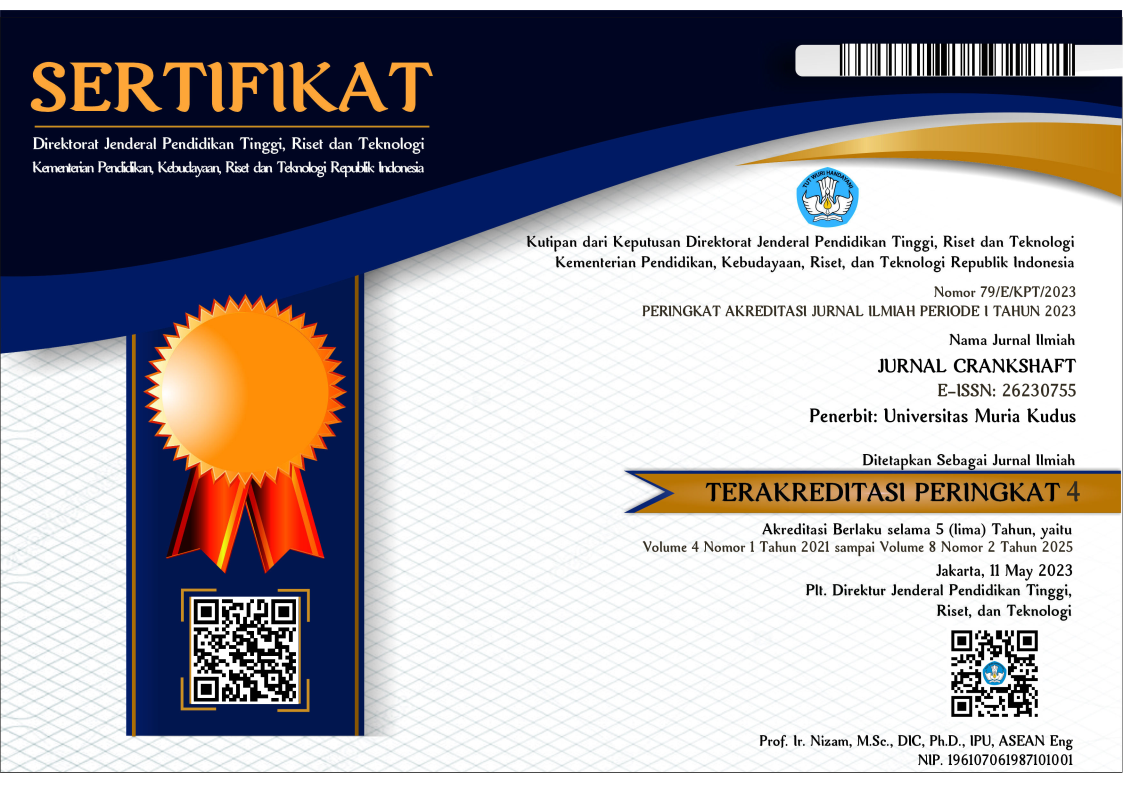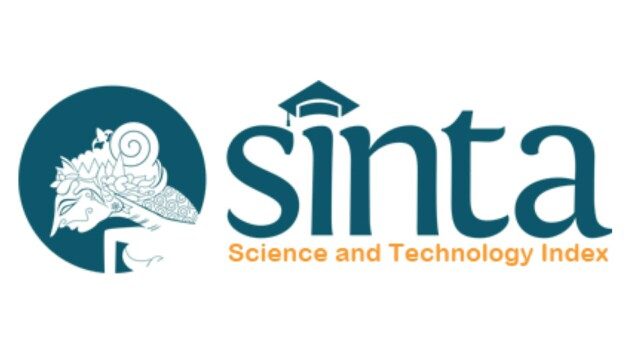Platform Swerve Drive Modular untuk Robot Mobile Otonom Menggunakan ESP32
Sari
Penelitian ini bertujuan untuk merancang dan mengimplementasikan platform swerve drive modular untuk robot mobile otonom berbasis mikrokontroler ESP32, guna memungkinkan manuver omnidireksional yang presisi dalam lingkungan dinamis. Sistem dikembangkan menggunakan pendekatan kinematika invers untuk mengatur kecepatan dan arah sudut setiap roda secara independen. Validasi dilakukan melalui pengujian gerakan dasar serta analisis performa aktuator terhadap variasi kecepatan putar roda (RPM). Hasil pengujian menunjukkan bahwa sistem mampu menghasilkan kecepatan linier maksimum sebesar 0,314 m/s pada 100 RPM, dengan error sudut rata-rata berada dalam rentang ±1,2° hingga ±2,7°. Grafik hubungan antara RPM dan error sudut menunjukkan adanya degradasi presisi pada kecepatan tinggi, yang menandakan keterbatasan respons servo dan sistem kontrol berbasis ESP32. Temuan ini menunjukkan bahwa sistem yang dikembangkan efektif pada kecepatan rendah-menengah dan layak digunakan dalam aplikasi robotik otonom berskala kecil. Penelitian ini memberikan kontribusi terhadap desain platform robot modular yang ekonomis, fleksibel, dan adaptif, serta membuka peluang pengembangan lanjutan melalui integrasi kontrol prediktif dan sensor presisi tinggi.
Kata kunci: swerve drive, robot otonom, ESP32, kinematika robot, kontrol motor.
Teks Lengkap:
PDFReferensi
Cheng, L. et al., 2023. “A mobile sensing system for future gas mapping in confined space using an olfactory quadruped robot. Measurement, 213.112654.
Ullah, L. et al., 2024. “Mobile robot localization: Current challenges and future prospective”. Comput Sci Rev, 53.100651.
Kabir, H. et al., 2023. “Internet of robotic things for mobile robots: Concepts, technologies, challenges, applications, and future directions.” Digital Communications and Networks, 9.6, 1265–90.
Ishihara, Y. dan Takahashi, M. 2023. “Empirical study of future image prediction for image-based mobile robot navigation”. Rob Auton Syst, 150.104018.
Chand, R. et al., 2025. “Systematic review of mobile robots applications in smart cities with future directions”. J Ind Inf Integr, 45.100821.
Nwachioma, C dan Pérez-Cruz. 2021. ”Analysis of a new chaotic system, electronic realization and use in navigation of differential drive mobile robot”. Chaos Solitons Fractals, 144.110684.
Xing, J. Et al., 2024. “Analysis of bifurcation and chaotic behavior of the micro piezoelectric pipe-line robot drive system with stick - slip mechanism”. Commun Nonlinear Sci Numer Simul, 2024. 134.107998.
Kabir, H. et al., 2023. “Internet of robotic things for mobile robots: Concepts, technologies, challenges, applications, and future directions”. Digital Communications and Networks, 9.6, 1265–90.
Lee, H. et al., 2025. “Programmable hybrid-drive actuator for compact and bimodal continuum robot modules”. Int J Mech Sci, 297.298, 110380.
Hansen, S. Et al., 2025. “Machining of large CFRP-components with industrial robots with hybrid drives”. Procedia CIRP, 131, 62–7.
Treesatayapun, C. 2020. “Robotic architecture as unknown discrete-time system based on variable-frequency drive and adaptive controller”. Robot Comput Integr Manuf, 64.101951.
Correa-Hernando, E. et al., 2011. “Development of model based sensors for the supervision of a solar dryer”. Comput Electron Agric, 8.2, 167–75.
Cheng, L. et al., 2023. “A mobile sensing system for future gas mapping in confined space using an olfactory quadruped robot”. Measurement, 213.112654.
Gao, Z. Et al., 2020. “Distributed active disturbance rejection control for Ackermann steering of a four-in-wheel motor drive vehicle with deception attacks on controller area networks. Inf Sci (N Y), 540, 370–89.
Bascetta, L. et al., 2016. “Kinematic trajectory tracking controller for an all-terrain Ackermann steering vehicle”. IFAC-PapersOnLine, 49.15, 13–8.
Lei, C. Et al., 2025. “Improved RRT* path planning method for Ackermann steering vehicles”. Expert Syst Appl, 279.127349.
Zhang, H. et al., 2023. “Energy efficient path planning for autonomous ground vehicles with ackermann steering’”. Rob Auton Syst,162.104366.
Hu, J. Et al., 2023. “Trajectory Planning Method for Autonomous Vehicle in Narrow Passages. In: 2023 6th International Conference on Mechatronics”. Robotics and Automation (ICMRA), 114–9.
Grand View Research. 2025. “Autonomous Mobile Robots Market Trends”. market. 2025.
IEEE. 2022. “IEEE Embedded Systems Letters Publication Information”. IEEE Embed Syst Lett, 14.1, C2–C2.
Mukhtar, A. Et al., (2023). “SENSOR DAN AKTUATOR: KONSEP DASAR DAN APLIKASI”. Widina Media Utama.
Hermana, R., et al. (2023). “DASAR DAN APLIKASI ROBOTIKA INDUSTRIAL MANUFAKTUR 4.0”. Bandung: Penerbit Widina Media Utama.
Rohmansyah, A. 2024. “Pemodelan kinematika four wheel swerve drive menggunakan pendekatan geometri dan trigonometri”. Jurnal Elektronika dan Otomasi Industri, 11.2, 456–63.
Shi, Y. et al., 2023. “Path Tracking Control of Self-Reconfigurable Robot hTetro with Four Differential Drive Units”. IEEE Robotics and Automation Letters, 5.3, 3998–4005.
Adinugraha et al., 2023. “Desain dan Kontrol Modular Independent Drive Independent Steering Mobile Robot Aktuator”. Metrotech (Journal of Mechanical and Electrical Technology), 2.3, 144–50.
Name, P. et al., 2023. “Overall Similarity The combined total of all matches, including overlapping sources , for each database”. Crossref Posted Content database.
Julyus, M. et al., 2020. “Robot Beroda Otonom dengan Invers Kinematics Autonomous Wheeled Robot Control with Inverse Kinematics’. Jurnal Ilmu Komputer Agri-Informatika, 7.1, 62–73.
Studi, P. et al., 2024. “Pengembangan Sistem Kendali Mekanis Mobile Robot Menggunakan Roda Caster”. Jurnal Ilmiah Teknik Mesin, 1–7.
Auzan, M. et al., 2021. “Path Tracking and Position Control of Nonholonomic Differential Drive Wheeled Mobile Robot”. Jurnal Ilmiah Teknik Elektro Komputer dan Informatika, 7.3, 368.
Stephen et al., 2021. “Perancangan Kontrol Pelacakan Lintasan untuk Robot Otonom Bergerak Beroda dengan Penggerak Diferensial”. Jurnal Nasional Teknik Elektro dan Teknologi Informasi, 10.3, 272–81.
DOI: https://doi.org/10.24176/cra.v8i2.15136
Refbacks
- Saat ini tidak ada refbacks.
##submission.license.cc.by-nc-sa4.footer##
Indexed by:
Jurnal Crankshaft is licensed under a Creative Commons Attribution-ShareAlike 4.0 International License.
Dedicated to:







